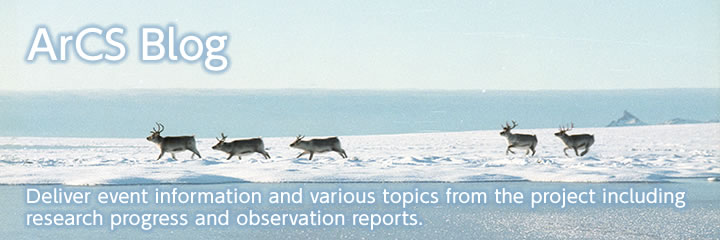The International Symposium, “On Land, Water and Ice: Indigenous Societies and the Changing Arctic” was held on July 5 and 6 at the Slavic-Eurasian Research Center, Hokkaido University. Making a feature of the various changes that confront the indigenous people in the Arctic, the symposium had two keynote speeches on the first day, which were followed by five sessions of presentations over two days.

Although consensus is growing among scientists that global warming is affecting the Arctic, some members of the public are skeptical and suspect that scientists may be overstating the risks. Actually, the argument that global warming is untrue may never disprove scientific findings of the phenomena. But, there is a suspicion that scientists are overemphasizing the warming tendency. The things that researchers connected with the ArCS project should do for the public is to explain to them the real situation of the Arctic by interpreting data from multifarious points of view.
Observations identified changes in the Arctic terrestrial water cycle caused by increasing snow and warming permafrost under the condition of warming climate. It is expected that the declining sea ice is associated with the changes of water cycle. The declination enhances evaporation from the open sea surface, resulting in wetter atmosphere and hence larger snow on land through atmospheric dynamics. The increased snow contributes to permafrost warming and the increase of river discharge.
I stayed at the Alfred Wegener Institute (AWI) in Germany from 3 March to 31 May 2018 with funding from the ArCS’ program for young researchers overseas visits. Bremerhaven, where I stayed, was a peaceful port town. People there enjoyed drinking beer and walking along the river banks every evening.
We have released the summer Arctic sea-ice forecast of this year.
http://ccsr.aori.u-tokyo.ac.jp/~kimura_n/arctic/2018e.html
*You can access same contents from https://ads.nipr.ac.jp/vishop/
- Research
I stayed in North-Eastern Federal University (NEFU) in Yakutsk for 39 days, from October to November 2017.
The purpose of my stay was to carry out a research aiming to elucidate effects of CO2 emission reduction through the modernization of lighting system in NEFU. My supervisor in NEFU is Professor Tuyara and during my stay she have given me insightful advice on my research. I also got sincere cooperation as to data provision and frequent meetings from the director of AMTEK+, the company in charge of the modernization of lighting system. It also worth noting that the research environment was quite satisfying. I could use a spacious joint laboratory between NEFU and Hokkaido University in the “Arctic Innovation Center”. It was helpful as well to be able to use the laboratory for a long time in a day. Thanks to such comfortable circumstances, I could carry out my research without any trouble.
Consequently, it has been elucidated that the modernization of the lighting system has brought about a reduction in annual electricity cost. In addition, I was able to collect necessary data to assess CO2 emission reduction.
We began our field campaign in Qaanaaq, northwestern Greenland on 4 July. The ocean in front of the village was covered with sea ice when we arrived. However, the sea ice has disappeared and only icebergs are remaining in the ocean. After the sea ice disappeared, a large transport ship arrived at the village. The ship supplied a lot of materials to a supermarket, which made everyone happy after a long winter spent without ship transport. The ship tells us the arrival of summer in the village.
Now, I am in an old cafe in Kobe, a historical port town in Japan, and listening to a record of languid JAZZ music. I stayed in the Netherlands (Arctic station, University of Groningen) and some other European countries for nine and a half months from March 2017 to January 2018. In particular, it was an amazing experience to stay and research in Spitsbergen Island, Norway, with Dr. Maarten J.J.E. Loonen and his Dutch team for two months during summer. Now I close my eyes and vividly remember the fantastic days in Spitsbergen Island again. That was an incredible, much like a beautiful dream – a priceless experience.
I stayed at Glaciers Group of Geophysical Institute in University of Alaska Fairbanks for four months from May until September, 2017 (Photo 1). The purpose of the visit was to discuss and analyze my field data obtained during the previous fieldwork campaigns in Patagonia and Greenland. Also, my aim was to conduct fieldwork in an Alaskan glacier for a comparative study, as well as to establish a cooperative framework with the people at the university.
Aalborg, the fourth largest city in Denmark (See Photo 1), is known as the town in which the largest number of Greenlanders in Denmark live (See the following article in Greenland’s national newspaper Sermitsiaq, electronic edition, March 7, 2018: “Rekordmange grønlændere bor i Danmark”) (Also, see Photo 2). The city also has strong industrial and trade ties with Greenland - there is a port that serves as a major transport hub in the exchange with Greenland (Greenland Havn) and the headquarters of Royal Greenland, the world’s largest supplier of maritime products, are located. Thanks to the financial support of the ArCS’ Program for Overseas Visits by Young Researchers, I was blessed with the opportunity to spend ten months, from 20 March 2017 to 31 January 2018, in that city where, although in Denmark, one can feel the presence of Greenland a lot.




